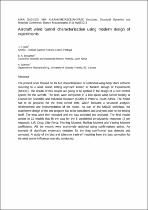JavaScript is disabled for your browser. Some features of this site may not work without it.
- ResearchSpace
- →
- Research Publications/Outputs
- →
- Conference Publications
- →
- View Item
| dc.contributor.author |
Dias, JF

|
|
| dc.contributor.author |
Broughton, BA

|
|
| dc.contributor.author |
Suleman, A

|
|
| dc.date.accessioned | 2013-06-19T11:44:56Z | |
| dc.date.available | 2013-06-19T11:44:56Z | |
| dc.date.issued | 2013-04 | |
| dc.identifier.citation | Dias, J.F, Broughton, B.A and Suleman, A. 2013. Aircraft wind tunnel characterisation using modern design of experiments. In: AIAA 2013-1502, 54th AIAA/ASME/ASCE/AHS/ASC Structures, Structural Dynamics and Materials Conference, Boston, Massachusetts, 8-11 April 2013 | en_US |
| dc.identifier.uri | http://arc.aiaa.org/doi/abs/10.2514/6.2013-1502 | |
| dc.identifier.uri | http://hdl.handle.net/10204/6806 | |
| dc.description | AIAA 2013-1502, 54th AIAA/ASME/ASCE/AHS/ASC Structures, Structural Dynamics and Materials Conference, Boston, Massachusetts, 8-11 April 2013. Published in Aerospace Research Central | en_US |
| dc.description.abstract | The present work focused on the full characterisation of a blended-wing-body UAV airframe recurring to a wind tunnel testing approach known as Modern Design of Experiments (MDOE). The results of this project are going to be applied in the design of a new control system for the aircraft. The tests were completed in a low-speed wind tunnel facility at Council for Scientific and Industrial Research (CSIR) in Pretoria, South Africa. The model had to be prepared for the wind tunnel tests, which included a structural analysis, reinforcement and instrumentation of the model. As part of the MDOE technique, the experiment design of the test program had to be considered and analysed prior to the testing itself. The tests were then executed and the data collected and analysed. The final results consist in 12 models that fit the data for the 6 considered aerodynamic responses (2 per response): Lift, Drag, Side Force, Pitching Moment, Rolling Moment and Yawing Moment coefficients. All the models were extensively analysed using confirmations points. An example of significant systematic variation for the drag coefficients was detected and corrected. A study of the bias and tolerance trade-off resulting from the data correction for the wind tunnel influences was also conducted. | en_US |
| dc.language.iso | en | en_US |
| dc.publisher | Aerospace Research Central | en_US |
| dc.relation.ispartofseries | Workflow;11025 | |
| dc.subject | Aircraft wind tunnel testing | en_US |
| dc.subject | Modern design of experiments | en_US |
| dc.subject | Structural dynamics | en_US |
| dc.title | Aircraft wind tunnel characterisation using modern design of experiments | en_US |
| dc.type | Conference Presentation | en_US |
| dc.identifier.apacitation | Dias, J., Broughton, B., & Suleman, A. (2013). Aircraft wind tunnel characterisation using modern design of experiments. Aerospace Research Central. http://hdl.handle.net/10204/6806 | en_ZA |
| dc.identifier.chicagocitation | Dias, JF, BA Broughton, and A Suleman. "Aircraft wind tunnel characterisation using modern design of experiments." (2013): http://hdl.handle.net/10204/6806 | en_ZA |
| dc.identifier.vancouvercitation | Dias J, Broughton B, Suleman A, Aircraft wind tunnel characterisation using modern design of experiments; Aerospace Research Central; 2013. http://hdl.handle.net/10204/6806 . | en_ZA |
| dc.identifier.ris | TY - Conference Presentation AU - Dias, JF AU - Broughton, BA AU - Suleman, A AB - The present work focused on the full characterisation of a blended-wing-body UAV airframe recurring to a wind tunnel testing approach known as Modern Design of Experiments (MDOE). The results of this project are going to be applied in the design of a new control system for the aircraft. The tests were completed in a low-speed wind tunnel facility at Council for Scientific and Industrial Research (CSIR) in Pretoria, South Africa. The model had to be prepared for the wind tunnel tests, which included a structural analysis, reinforcement and instrumentation of the model. As part of the MDOE technique, the experiment design of the test program had to be considered and analysed prior to the testing itself. The tests were then executed and the data collected and analysed. The final results consist in 12 models that fit the data for the 6 considered aerodynamic responses (2 per response): Lift, Drag, Side Force, Pitching Moment, Rolling Moment and Yawing Moment coefficients. All the models were extensively analysed using confirmations points. An example of significant systematic variation for the drag coefficients was detected and corrected. A study of the bias and tolerance trade-off resulting from the data correction for the wind tunnel influences was also conducted. DA - 2013-04 DB - ResearchSpace DP - CSIR KW - Aircraft wind tunnel testing KW - Modern design of experiments KW - Structural dynamics LK - https://researchspace.csir.co.za PY - 2013 T1 - Aircraft wind tunnel characterisation using modern design of experiments TI - Aircraft wind tunnel characterisation using modern design of experiments UR - http://hdl.handle.net/10204/6806 ER - | en_ZA |






